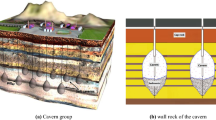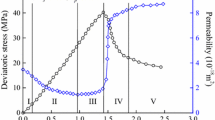Abstract
The properties of rock resitivity were studied under pressure, particularly with “stress reversal”, a procedure in which the pressure applied was increased and decreased.
It was observed that, 1) With pressure increasing, the main feature of resistivity change was increase-steady-decrease for high-saturation rock samples (saturation 70–100%). But the main feature for low-saturation samples was different. 2) In 10 out of 11 cases of “stress reversal” for high-saturation samples the resistivity droped (about 2%). Such drop could explain the anomalies in geoelectricity terms, which are commonly observed before earthquakes in China. 3) It was also observed shortly before rock failure that, a) the resistivity drops more dramatically (about 20%) during “stress reversal” period, which is much more than ordinary drops. b) these drops occurred not only during stress decrease but also during stress increase. c) Resistivity exhibits anisotropy: the resistivity along different directions may differ by 10%. These three features may indicate that the rock is nearing failure, while ordinary resistivity drops are only connected with “stress reversal” and may not mean the imminence of rock failure. 4) Resistivity increase was observed during the “stress reversal” period for low-saturation rock samples.
The results mentioned above were explained with the effect of water flowing in and out of the cracks of rock. The temporary factors which yield a reduction of the maximum main stress, may enhence the possibility of earthquake occurrence.
Similar content being viewed by others
References
耿 乃光, {at应力减小引起地震, 地震学报, 1985, 7, 445-451.
陈 大元, 陈 峰, 王 丽华, 贺} 国玉, 戴 经安, 单轴压力下岩石电阻率的研究—电 阻率的各向异性, 地球物理学报, 1983, 26, 784-792.
北京大学地球物理教研室, **科学院地质所三室, 岩石的结构, 成份与它在单向压力下电阻率变 化的初步研究, 地震战线,1973, 4: 9-15.
钱 复生, 赵 玉林, 地震前地电阻率变化十例, 地震学报,1980, 2, 186-197.
赵 玉林, 钱 复生, 唐山7.8级**震前震中周围形变电阻率 的下降异常, 地球物理学报,1978, 21, 181-182.
Φ.:.萨瓦连斯基, 工程地质手册, 135, 地震出版社翻译, 1959, 第一版.1959,
Author information
Authors and Affiliations
About this article
Cite this article
Dayuan, C., Feng, C. & Guoyu, H. Influence of “stress reversal” on rock resistivity during loading procedure. Acta Seismologica Sinica 1, 84–92 (1988). https://doi.org/10.1007/BF02652497
Received:
Accepted:
Issue Date:
DOI: https://doi.org/10.1007/BF02652497




